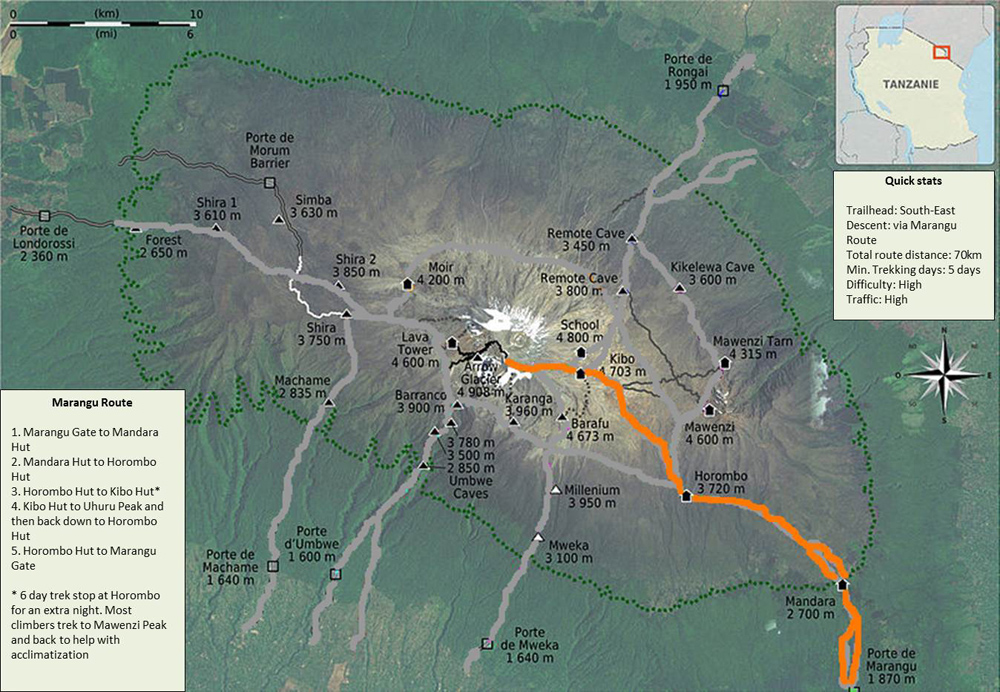Day 1:
Pick up from Arusha town or Kilimanjaro International Airport and transfer to Moshi town, which is commonly known as the gateway to Mount Kilimanjaro. Half Board accommodation at a Base Hotel in Moshi.
Day 2:
After breakfast and a short tour briefing from the guide, we will depart to Marangu gate of Kilimanjaro National Park (it is a 45-minute drive from Moshi to the Marangu Gate). Upon registering with park authorities, our climb will officially commence with a four-hour walk to the Mandara encampment. We will pass through a thick rainforest zone, where there is a high chance of rain in the afternoon. We will spend the night at Mandara Hut (2,750m), an attractive collection of buildings. Bathrooms are available with running water.
Day 3:
Today we will continue our ascent through the forest for a short time, before reaching the heather and moorland zone at roughly 3,000m (approximately a six-hour walk). Enjoy stunning views of the mountain peaks at this altitude. We will spend the night at Horombo Hut (3,720m), which lies in a valley surrounded by giant lobelia and groundsel, flora which are characteristic of this semi-alpine zone. Bathrooms are available with running water.
Day 4:
Our trek continues past the final watering point, and ascends onto the saddle of Kilimanjaro, between the peaks of Kibo and Mawenzi. The vegetation thins out as we enter the desert-like alpine zone (approximately 4,000m) and, once we cross the saddle, Kibo peak comes into view. The saddle is an alpine desert that resembles a lunar landscape. Be careful to notice signs of altitude sickness. This seven-hour walk will be taken at a slow pace. We will spend the night at Kibo Hut (4,703m), a comfortable stone construction (no running water at Kibo Hut). This semi-desert zone receives an annual rainfall of under 250mm; the ground often freezes at night, but ground temperatures soar to above 30 degrees Celsius by day. Few plants other than lichens and grasses survive in these conditions.
Day 5:
Shortly after midnight, we will commence our climb to the summit of Kilimanjaro, since it is easier to climb the scree slope to Gillman's Point (5,861m) on the crater rim when it is frozen and an early start for the six-hour hike improves our chances of reaching the summit in time for sunrise. From Gilman's Point, it is a further two-hour round trip along the crater's edge to Uhuru Peak, the highest point in Africa. From the summit, it is downhill all the way to Horombo Hut where we will spend our last night on the mountain.
Day 6:
Today’s descent continues past the Mandara encampment to the bottom of the mountain, where each hiker will receive a well-earned certificate. From here, you will be transferred to a Base Hotel in Moshi for dinner and overnight.
Day 1:
Pick up from Arusha town or Kilimanjaro International Airport and transfer to Moshi town, which is commonly known as the gateway to Mount Kilimanjaro. Half Board accommodation at a Base Hotel in Moshi.
Day 2:
After breakfast and a short tour briefing from the guide, we will depart to Marangu gate of Kilimanjaro National Park (it is a 45-minute drive from Moshi to the Marangu Gate). Upon registering with park authorities, our climb will officially commence with a four-hour walk to the Mandara encampment. We will pass through a thick rainforest zone, where there is a high chance of rain in the afternoon. We will spend the night at Mandara Hut (2,750m), an attractive collection of buildings. Bathrooms are available with running water.
Day 3:
Today we will continue our ascent through the forest for a short time, before reaching the heather and moorland zone at roughly 3,000m (approximately a six-hour walk). Enjoy stunning views of the mountain peaks at this altitude. We will spend the night at Horombo Hut (3,720m), which lies in a valley surrounded by giant lobelia and groundsel, flora which are characteristic of this semi-alpine zone. Bathrooms are available with running water.
Day 4:
Our trek continues past the final watering point, and ascends onto the saddle of Kilimanjaro, between the peaks of Kibo and Mawenzi. The vegetation thins out as we enter the desert-like alpine zone (approximately 4,000m) and, once we cross the saddle, Kibo peak comes into view. The saddle is an alpine desert that resembles a lunar landscape. Be careful to notice signs of altitude sickness. This seven-hour walk will be taken at a slow pace. We will spend the night at Kibo Hut (4,703m), a comfortable stone construction (no running water at Kibo Hut). This semi-desert zone receives an annual rainfall of under 250mm; the ground often freezes at night, but ground temperatures soar to above 30 degrees Celsius by day. Few plants other than lichens and grasses survive in these conditions.
Day 5:
Shortly after midnight, we will commence our climb to the summit of Kilimanjaro, since it is easier to climb the scree slope to Gillman's Point (5,861m) on the crater rim when it is frozen and an early start for the six-hour hike improves our chances of reaching the summit in time for sunrise. From Gilman's Point, it is a further two-hour round trip along the crater's edge to Uhuru Peak, the highest point in Africa. From the summit, it is downhill all the way to Horombo Hut where we will spend our last night on the mountain.
Day 6:
Today’s descent continues past the Mandara encampment to the bottom of the mountain, where each hiker will receive a well-earned certificate. From here, you will be transferred to a Base Hotel in Moshi for dinner and overnight.

